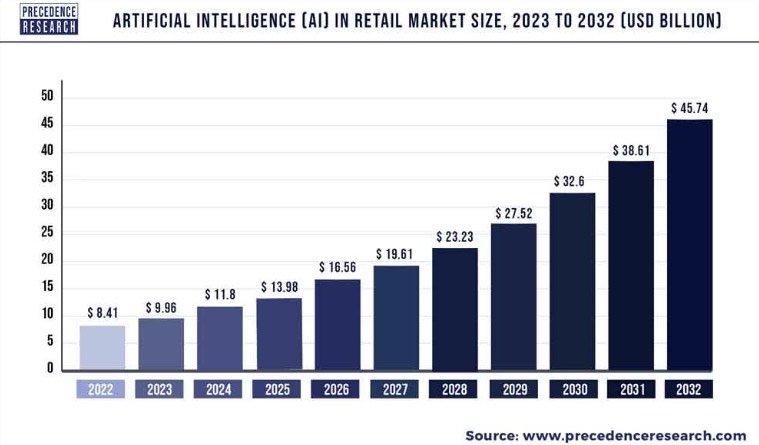 Reading Time: 8 minutes
Reading Time: 8 minutesIntroduction
In the retail industry, the integration of artificial intelligence (AI) has become inevitable, as it is swiftly reshaping the way businesses operate and consumers experience shopping.
From enhancing personalized customer experiences to optimizing supply chain management, AI has proven its potential to impact almost every facet of the retail ecosystem. In this era of rapid technological advancement, the pace at which AI is being embraced not only reflects the industry’s commitment to staying ahead but also raises intriguing questions about the inevitable advent of Generative AI (Gen AI).
As the adoption of AI technologies gains momentum, retailers are hard-pressed to learn to navigate a dynamic terrain where innovation and efficiency intersect. In this blog, we delve into the current state of AI adoption in retail and explore the implications of this accelerating trend on the future, contemplating the eventual integration of Gen AI into the fabric of the retail experience.
The current state of AI in retail
Artificial Intelligence (AI) and Machine Learning (ML) have emerged as indispensable tools, empowering businesses to unlock unprecedented insights and efficiencies. AI applications in retail are diverse, ranging from customer-facing innovations to backend operations.
On the customer front, retailers are harnessing AI to offer personalized shopping experiences, leveraging recommendation engines that analyze past behaviors to predict future preferences. Chatbots equipped with natural language processing capabilities enhance customer service, providing instant assistance and streamlining communication. Moreover, AI-driven image recognition and augmented reality are changing the very essence of how customers see products before making purchasing decisions.
Behind the scenes, machine learning algorithms are optimizing inventory management, predicting demand patterns, and minimizing supply chain disruptions. Retailers are increasingly turning to AI to enhance pricing strategies, dynamic promotions, and fraud detection, demonstrating a comprehensive integration of these technologies across various touchpoints. As we witness these advancements, it becomes evident that the retail sector is not merely dabbling in AI; rather, it is wholeheartedly embracing the technology to elevate the entire shopping journey.
All major technology companies have forayed into AI products and some of them like the Salesforce Einstein, the IBM Watson, the Google AI platform, and Microsoft’s Azure ML are heavily used in retail marketing and customer analytics. Amazon Rekognition performs image and video analysis for tasks like product recognition and inventory management, whereas SAP Leonardo Integrates AI and IoT for smart retail solutions, including demand forecasting, supply chain visibility, and customer experience enhancement.
Retail giants such as Kroger, Lowe’s, and Amazon are making substantial investments in AI to minimize manual errors, enhance inventory monitoring, and implement intelligent loading and unloading processes across their stores and warehouses. The recent surge in AI-related mergers and acquisitions further reinforces our conviction that retailers are actively integrating AI advancements to optimize their operations.
As per Precedence Research(refer figure 1), the global artificial intelligence (AI) in retail market size accounted for USD 8.41 billion in 2022 and it is projected to attain around USD 45.74 billion by 2032, poised to grow at a CAGR of 18.45% during the forecast period 2023 to 2032.

How and where is Gen AI applicable in retail?
Generative AI is characterized by its ability to autonomously create content, ranging from text to images and beyond. In the era of rapid technological evolution, the advent of Gen AI has given rise to some interesting opportunities in the retail landscape. This technology is ushering in a new era in retail, where the fusion of artificial intelligence and commerce is giving rise to innovative solutions and unparalleled efficiency.
The impact of Gen AI on the retail sector is palpable and multifaceted. Accenture’s Technology Vision 2023 research found almost all (96%) retail executives are saying they’re very or extremely inspired by the new capabilities offered by foundation models (the technology that underpins Generative AI applications like ChatGPT). The same research found more than nine in ten executives saying foundation models will play an important role in their retail strategies in the next three to five years. And over half of those surveyed already have their eyes on Generative AI experiments in areas like customer support and process automation.
Its ability to create personalized and engaging customer experiences is revolutionizing the way retailers connect with their audience. From tailoring product recommendations based on individual preferences to enhancing virtual shopping experiences, Gen AI is reshaping the dynamics of consumer interaction. It also has the potential of transforming supply chain and inventory management and bolstering the security measures involved. Gen AI is proving to be a versatile tool that addresses diverse challenges in the retail ecosystem. This shift is not merely theoretical but is being actively embraced by industry leaders who recognize the immense potential of Gen AI to elevate the retail experience.
Let’s dive deeper into the facets of Retail where Gen AI has already started making dents or at the least, promising advances:
Content generation
Generation of novel, innovative, and aesthetically superior content is arguably the single largest application of Generative AI. In addition to creating multi modal content, they can automate content creation making it easier for online platforms to offer fresh and relevant content. Each of the below areas are direct use cases for content generation which make a significant impact on customer engagement and boost sales.
Generation of marketing content: Creating marketing emails with engaging subject lines and generating push notifications with automated and personalized content are a few of the vast possibilities of GenAI applicability in this area. Domino’s Pizza and eBay are examples of companies using AI-enhanced content.
Product description: Generating product descriptions in line with a specific brand tone and language, incorporating necessary SEO keywords, and ensuring grammatical correctness are some of the benefits of using Gen AI powered tools. Tools like Phrasee can analyze product attributes and produce innovative descriptions.
Product images and ads generation: Generative Adversarial Networks (GANs), a subcategory of Generative AI has found immense popularity in retail and ecommerce. Once trained on an existing set of images they can produce new and enhanced images which can be used in offline promotional activities and online product display pages. Tools like DALL-E 2 are already making headway into advertising. Nestle, for example, used an AI version of a Johannes Vermeer painting to promote its yogurt brand, while Mattel, the global toy company, is using this technology to produce images for toy design.
Improving customer service
Customer service is one area which has not been completely demystified by retailers as it requires human involvement and scalable resources at some level. AI Chatbots do provide some assistance but fails to provide human like responses and is limited to generic queries. After the adoption of ChatGPT and other Large Language Models (LLMs) though, organizations have started embracing Gen AI to develop their customer service assistants.
Large Language Models or LLMs, a significant part of Gen AI, are transforming the face of customer service by facilitating the creation of user friendly and human like chatbots with sensible and contextual conversations. Some companies have quickly integrated off-the-shelf LLM APIs into their chat bots while others have started customizing open source foundational LLMs for their needs.
In this context, LangChain, a software development platform has emerged as a major player allowing developers to leverage LLMs and create high quality chatbots for eCommerce platforms. It provides integration with LLM providers such as OpenAI and Hugging Face, enabling an easy-to-use and understand user interaction interface.
As a result of integrating Gen AI-driven chatbots, businesses are experiencing a significant reduction in response times and an enhancement in overall customer service satisfaction. These chatbots, equipped with natural language processing capabilities, provide instant, accurate and summarized responses to customer queries, enhancing the overall customer experience. Moreover, they free up human customer service representatives to focus on more complex issues, further streamlining customer support operations.
New product designs
Companies are also harnessing Gen AI for creating new product designs based on the existing ones. This saves a lot of time spent in aesthetics and structural consideration and reduces the time-to-market of any given product. For example, New Balance, an athletic footwear and apparel company, used generative design to craft unique shoe sole geometrics. It utilised a proprietary software developed by Nervous System, a generative design studio, which also allowed customization of soles as per customers’ requirements and aesthetic tastes. This type of approach blends structural functionality with personal preferences providing a unique and maximised customer experience.
Unleashing personalized customer experiences
Personalised recommendations have been around for quite some time. But with the power of Gen AI, companies now have access to vast amounts of data from varied sources blended with consumer’s historical preferences and real-time behavioural data, enabling them to provide highly targeted real time product suggestions. These suggestions may be different than what is predicted by a traditional recommendation algorithm and depend on the customer’s current day preference, requirement, or mood.
These models can handle complex customer queries and deliver relevant responses. It can also leverage customer data to provide personalized answers.
Generative AI extends its ability to personalize customer experiences by generating customized content and adapting the user interface. A practical application involves using Generative AI to create personalized product descriptions or adjust website layouts according to individual customer preferences. This strategy not only elevates the overall user experience but also plays a crucial role in fostering customer retention and loyalty.
Optimizing supply chain and inventory management
Generative AI is excellent in summarizing information from structured and unstructured data sources. This makes it perfect for asking queries for real-time updates on inventory and supply chain status. It is also being evaluated for quickly analysing and modifying strategies, route planning, and resource allocation in real-time.
Gen AI enables accurate demand predictions, minimizes excess inventory, implements best practices, and finds new suppliers that fit your business, environmental, and ethical goals. In other words, it can streamline the entire supply chain process. The result is improved operational efficiency and substantial cost savings for retailers. With LLM APIs being available commercially they can be easily integrated into your existing supply chain software.
Enhancing fraud detection and security
Security concerns in eCommerce can be effectively mitigated by Gen AI. Gen AI’s ability to analyze vast datasets in real-time enables the identification of irregular patterns and potential security threats, ensuring a secure online environment for both businesses and consumers. This not only safeguards financial transactions but also builds trust in the digital shopping experience.
Another better use case of Gen AI is that of alerting customer of any fraud risk and increasing awareness of diverse types of scams and fraud.
Recognizing the challenges and risks
While Generative AI brings forth several possibilities, it is not without its challenges and risks. Understanding and addressing these concerns is crucial for responsible deployment and effective integration into various domains. Mitigating risks and security considerations in utilizing consumer data is of utmost importance.
Hallucinations in the form of fabricated reviews, fictitious campaigns, and illusionary inventory are major challenges which can dent a brand image. Lack of explainability, bias in customer targeting, and over reliance on AI can lead to a clear disconnect between generated and real-world context, provoking consumers to question a retailer’s identity and trustworthiness.
Deploying Gen AI systems with all these considerations, and at scale, poses serious cost concerns for companies of all sizes. Finding an effective cost benefit analysis strategy and understanding the ROI might also be complicated.
Prospects and conclusion
As we witness the early stages of Gen AI’s impact on retail, it becomes clear that this technology is not just a fleeting trend but a strategic move that heralds a new chapter in the industry’s quest for innovation and enhanced customer satisfaction. Companies like Amazon, Shopify, eBay, Etsy, and Alibaba are already ahead in the game by effectively utilizing Gen AI in their operations. The journey of Gen AI in retail has just begun, promising a future where adaptability and efficiency are key drivers of success in an ever-evolving market.
The future is full of possibilities with AI-powered agents, AR and VR shopping experiences, fully automated customer services, and new product developments with the combined superpowers of Generative AI and other emerging technologies.
If technology, governments, and businesses come together to put guardrails and effective policies around Generative AI (and AI in general), the future of retail holds the promise of unparalleled innovation, elevated customer experiences, and sustainable growth. By fostering responsible development and deployment, we can harness the transformative potential of Generative AI, ensuring it becomes a catalyst for positive change in the retail landscape, balancing technological advancement with ethical considerations and societal well-being.
Fosfor by LTIMindtree offers an exclusive range of AI-powered products, aiding global retailers in addressing intricate business challenges. These solutions encompass market share analysis, brand performance evaluation, customer loyalty enhancement, marketing investment optimization, demand forecasting, and supply chain optimization.
Fosfor has also embraced Gen AI and adopted several new features based on the technology. Wave in Refract (the Fosfor Insight Designer), creates quick code using GenAI for model training and testing, ultimately enhancing the efficiency of the data scientist, whereas Flow in Lumin (the Fosfor Decision Designer), provides seamless conversational data querying, elevating customer experiences and reducing time-to-insights.








